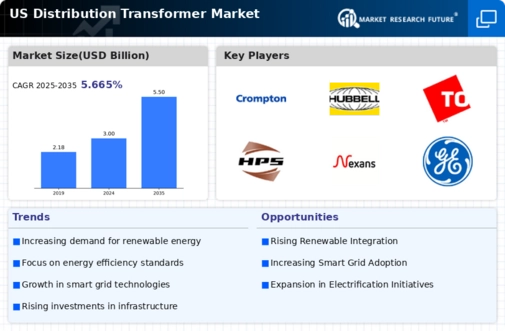Infrastructure Investment
Significant investments in infrastructure are propelling the distribution transformer market forward. The US government has recognized the need for modernization of the electrical grid, allocating substantial funds for upgrades and replacements. The Infrastructure Investment and Jobs Act, enacted in 2021, earmarks billions for enhancing energy infrastructure, including distribution transformers. This initiative aims to improve reliability and resilience against outages. As utilities receive funding for infrastructure projects, the demand for distribution transformers is expected to rise. The market could see an increase in installations, as utilities strive to meet regulatory requirements and enhance service delivery.
Rising Demand for Electricity
The increasing demand for electricity in the US is a primary driver for the distribution transformer market. As urbanization and population growth continue, the need for reliable power supply escalates. According to the US Energy Information Administration, electricity consumption is projected to rise by approximately 1.5% annually through 2025. This surge necessitates the installation of more distribution transformers to ensure efficient power distribution. Additionally, the shift towards electric vehicles and renewable energy sources further amplifies the demand for electricity, thereby impacting the distribution transformer market. Utilities are compelled to upgrade their infrastructure to accommodate this growing demand, which in turn stimulates market growth.
Regulatory Compliance and Standards
Regulatory compliance plays a crucial role in shaping the distribution transformer market. The US government has established stringent standards for energy efficiency and emissions, compelling manufacturers to innovate and produce compliant transformers. The Department of Energy has set efficiency standards that transformers must meet, influencing design and production processes. As utilities strive to comply with these regulations, the demand for high-efficiency distribution transformers is expected to rise. This regulatory landscape not only drives innovation but also ensures that the distribution transformer market aligns with national energy goals.
Integration of Renewable Energy Sources
The integration of renewable energy sources into the power grid is a significant driver for the distribution transformer market. As the US transitions towards cleaner energy, the need for efficient power distribution becomes paramount. The Energy Information Administration reports that renewable energy sources are expected to account for over 50% of new electricity generation capacity by 2025. This shift necessitates the deployment of advanced distribution transformers capable of handling variable loads and ensuring grid stability. Consequently, the distribution transformer market is likely to experience growth as utilities invest in technology that supports renewable energy integration.
Technological Innovations in Transformer Design
Technological innovations in transformer design are significantly influencing the distribution transformer market. Advances in materials and engineering have led to the development of more efficient and compact transformers. Innovations such as smart transformers, which incorporate digital technology for monitoring and control, are gaining traction. These transformers enhance operational efficiency and reduce maintenance costs. The market is witnessing a shift towards transformers that can adapt to changing load conditions and integrate with smart grid technologies. As utilities seek to optimize their operations, the demand for technologically advanced distribution transformers is likely to increase.

















Leave a Comment